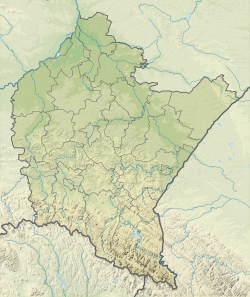Lesko Synagogue
| Lesko Synagogue | |
|---|---|
 The former synagogue in 2007, now part of the Muzeum Żydów Galicji | |
| Religion | |
| Affiliation | Hasidic Judaism (former) |
| Rite | Nusach Sefard |
| Ecclesiastical or organisational status |
|
| Status |
|
| Location | |
| Location | 16 Berka Joselewicza Street, Lesko, Podkarpackie Voivodeship |
| Country | Poland |
Location of the former synagogue, now museum, in Podkarpackie Voivodeship | |
| Geographic coordinates | 49°28′14″N 22°19′52″E / 49.4705155°N 22.3309994°E |
| Architecture | |
| Type | Synagogue architecture |
| Style | |
| Groundbreaking | 1626 |
| Completed | 1654 |
| Materials | Stone[a] |
| [2][3] | |
The Lesko Synagogue was a former Hasidic Jewish congregation and synagogue, located at 16 Berka Joselewicza Street, in Lesko, in the Podkarpackie Voivodeship of Poland.[2] The synagogue had functioned as a place of worship until 1942 when the building was deserted by the Nazis during World War II. In the 1980s the building was repurposed for use as part of the Muzeum Żydów Galicji (Museum of the Jews of Galicia), a Jewish history museum.
History
[edit]The synagogue was built between 1626 and 1654 by the Sephardic[4][b] Jewish community of Lesko.[1] By the twentieth century, it was one of six synagogues in the town, and the only one whose building survived the Second World War, although in a very damaged state; the interior was devastated by the German invaders of Poland.[1] For almost two decades after the war, it was neglected. It was renovated from the 1960s onwards.[1]
The building was constructed in the Mannerist and early Baroque style with characteristic gables decorated with volutes and stone baroque vases.[5] Some of the elements are gothic - buttresses, tower. The façade bears a Hebrew inscription that reads, in translation: "He was afraid and said, 'How awesome is this place! This is none other than the house of God; this is the gate of heaven'" (Genesis 28:17).[6] The interior was adorned in mannerist style with niches, cornices and architraves.[1]
Since the 1980s the synagogue is the site of Muzeum Żydów Galicji (Museum of the Jews of Galicia) and an art gallery that includes exhibits by artists of the Bieszczady region.[7]
Gallery
[edit]-
South-facing view
-
North-facing view (toward the city center)
-
The Ten Commandments
-
East-facing view
-
Interior, showing an art exhibition (2017)
See also
[edit]- History of the Jews in Poland
- List of active synagogues in Poland
- List of mannerist structures in Southern Poland
- List of museums in Poland
Notes
[edit]References
[edit]- ^ a b c d e "Synago". Virtual Sztetl. POLIN Museum of the History of Polish Jews. 2017. Retrieved July 31, 2024.
- ^ a b c "Synagogue in Lesko". Historic Synagogues of Europe. Foundation for Jewish Heritage and the Center for Jewish Art at Hebrew University of Jerusalem. n.d. Retrieved July 26, 2024.
- ^ Trzciński, Andrzej (2001). "1-2(7-8)". Zachowane wystroje malarskie bożnic w Polsce (in Polish). Studia Judaica 4. pp. 67–95.
- ^ "Lesko (Linsk) in Poland & your sephardic synagogue". eSefard. Liliana y Marcelo Benveniste. n.d. Retrieved July 31, 2024.
- ^ "Kościoły, cerkwie, synagogi". www.poland.gov.pl (in Polish). Archived from the original on September 25, 2009. Retrieved December 28, 2009.
- ^ "Synagoga". www.pascal.pl (in Polish). Archived from the original on February 24, 2012. Retrieved December 28, 2009.
- ^ Baranowska, E. (n.d.). Synagoga w Lesku. Lesko: Biesczadzki Dom Kultury. p. 10.
External links
[edit]- "Historia synagogi" (in Polish). Archived from the original on July 29, 2021.
- 17th-century synagogues in Poland
- Art museums and galleries in Poland
- Baroque synagogues in Poland
- Former synagogues in Poland
- Hasidic Judaism in Poland
- Hasidic synagogues
- Jewish museums in Poland
- Lesko County
- Mannerist architecture in Poland
- Museums in Podkarpackie Voivodeship
- Sephardi Jewish culture in Poland
- Sephardi synagogues
- Synagogues completed in 1654
- Synagogues preserved as museums
- Religious buildings and structures in Podkarpackie Voivodeship
- 20th-century attacks on synagogues and Jewish communal organizations
- European synagogue stubs
- Polish religious building and structure stubs








